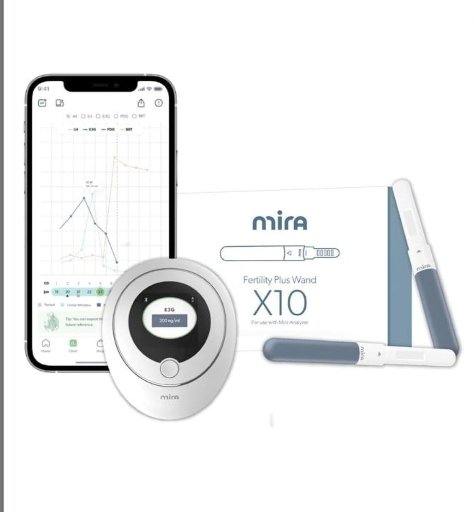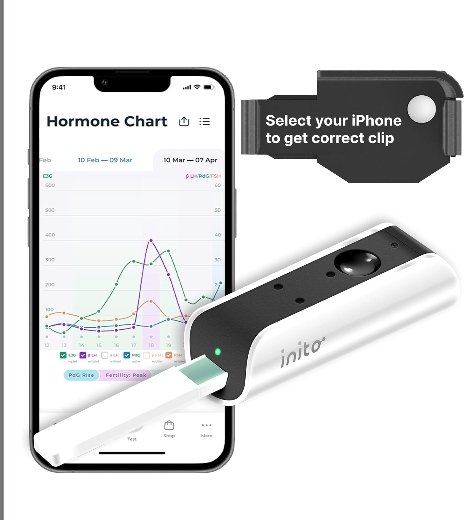Fertility trackers have become essential tools for those trying to conceive or better understand their menstrual cycles. Mira, Inito, and Proov are three popular hormone-based fertility monitors, each offering a unique approach. This comparison helps you understand how they work, what they measure, and which one fits your needs best.
Overview of Mira

Mira is a fertility tracker that measures urinary hormone levels using a handheld analyzer and test wands. It tracks Estrogen (E3G), Luteinizing Hormone (LH), Progesterone (PdG) (in specific wand types), and FSH (in some advanced models). Mira’s device connects to a mobile app that displays quantitative hormone levels, fertile windows, and cycle trends. It uses AI to personalize predictions based on your hormone patterns.
Pros and Cons of Mira
Pros
- Tracks up to four hormones
- Provides numeric hormone readings
- Personalized fertility insights via AI
- Lab-grade accuracy
- Reusable device with replaceable wands
Cons
- Higher upfront cost
- Requires separate wands for different hormones
- Bulkier device compared to Inito
- App may feel complex for first-time users
Overview of Inito

Inito is a compact, smartphone-connected fertility monitor. It uses test strips to measure Estrogen (E3G), Luteinizing Hormone (LH), and Progesterone (PdG). Users dip a strip in urine, insert it into the Inito reader (attached to a smartphone), and view results in the Inito app. It predicts fertile days and confirms ovulation in one system.
Pros and Cons of Inito
Pros
- Tracks three hormones (E3G, LH, PdG)
- Provides cycle prediction and confirmation
- Accurate numeric hormone values
- Compact, travel-friendly design
- Reusable device with low-waste strips
Cons
- Requires compatible smartphone
- Limited to urine tests
- May need daily testing during fertile window
Overview of Proov

Proov is a hormone test brand focused on confirming ovulation through PdG (progesterone) tracking. Its main product, Proov Confirm, uses test strips to measure PdG in the luteal phase, typically after ovulation. It also offers separate LH test strips for surge detection.
Pros and Cons of Proov
Pros
- Focuses on ovulation confirmation
- Simple test-strip method
- No device required
- Affordable for routine PdG tracking
- Optional app for digital tracking
Cons
- Does not predict ovulation
- Only tracks one hormone (PdG)
- Subjective interpretation without app
- No in-depth cycle analysis
FAQs
What is the main difference between Mira, Inito, and Proov?
The main difference lies in how many hormones they track and what they are designed to do. Mira measures up to four hormones (E3G, LH, PdG, and FSH) and offers full-cycle insights with advanced app support. Inito tracks three hormones (E3G, LH, PdG) and gives both ovulation prediction and confirmation. Proov focuses only on PdG to confirm ovulation after it happens.
Which device is best for predicting ovulation?
Inito and Mira are both excellent for predicting ovulation. They measure E3G and LH, which rise before ovulation. Proov does not predict ovulation—it only confirms whether it occurred based on PdG levels after the fertile window.
Which fertility tracker confirms ovulation most accurately?
All three can confirm ovulation, but the method differs. Inito and Mira measure PdG levels quantitatively through their readers and apps. Proov uses PdG test strips and confirms ovulation based on sustained progesterone levels during the luteal phase.
Is Mira more advanced than Inito?
Mira offers broader hormone tracking with the option to test FSH and PdG separately. It also uses AI to personalize predictions. However, Inito is more compact, cost-effective, and gives similarly accurate results for the three main fertility hormones. In terms of usability and portability, Inito has an edge.
Can I use Proov with irregular cycles?
You can use Proov, but it’s not ideal for irregular cycles unless paired with an LH test to find your surge. Since Proov is for post-ovulation confirmation, you need to know when ovulation likely occurred. For irregular cycles, Inito or Mira are better options because they monitor hormone trends throughout the cycle.
Does Mira offer numeric hormone results?
Yes. Mira provides lab-grade numeric hormone values for each hormone tested. You can see exact levels of E3G, LH, PdG, and FSH in the app, which helps in tracking patterns over time or sharing with a fertility specialist.
Does Inito give numerical hormone levels?
Yes. Inito displays precise numeric hormone values for E3G, LH, and PdG in its app. This allows users to understand exact hormone fluctuations and track ovulation with data rather than just color lines or symbols.
Is Proov app-based or strip-based?
Proov primarily uses test strips, but they also offer the Proov Insight app for logging results and viewing PdG levels across the luteal phase. However, the strips can be read visually if users prefer not to use the app.
Which one is most cost-effective?
Proov is generally the most affordable upfront, especially if you only need to confirm ovulation. Inito offers a balance between cost and features, while Mira has the highest initial cost, especially with different wand types for each hormone.
Can I use more than one device together?
Yes. Some users combine tools. For example, you might use Mira or Inito to predict ovulation and then use Proov to confirm progesterone levels post-ovulation. However, most users find that Inito or Mira alone are enough for both prediction and confirmation.
Is there a difference in hormone coverage?
Yes. Mira covers up to four hormones (E3G, LH, PdG, FSH), Inito covers three (E3G, LH, PdG), and Proov typically tracks only one (PdG) unless you buy separate LH strips.
Which is better for long-term hormone tracking?
Mira is best for users looking for long-term hormone data, especially when testing multiple hormones across multiple cycles. Inito is also excellent for tracking, especially for E3G, LH, and PdG. Proov is better for short-term use or for confirming a specific ovulation window.
Does Inito work with any phone?
Inito requires a compatible smartphone, as the test reader plugs directly into your device. It supports most modern Android and iOS phones. Always check Inito’s device compatibility list before purchasing.
Can Mira or Inito help with hormone imbalance?
Yes. Both Mira and Inito give insights into hormone patterns, which can help identify imbalances such as low estrogen, delayed LH surge, or low PdG levels. This data can be shared with a doctor or fertility specialist. For more advanced hormone health support, you may also consider exploring Femometer Ring vs Tempdrop or Femometer reviews.
Where can I learn more about hormone tracking tools?
You can explore additional comparisons like Inito vs Mira vs Kegg or Femometer vs Natural Cycles on our site. For brand-specific guides, check out the Inito blog, Mira’s website, or Clearblue’s early pregnancy insights.
Conclusion
Mira, Inito, and Proov each serve different purposes in fertility tracking. Choose Mira if you want the most comprehensive hormone testing, including FSH and long-term AI-based insights. Choose Inito if you want a balanced, all-in-one solution to predict and confirm ovulation with high accuracy in a compact design. Choose Proov if you mainly want to confirm ovulation after it happens and prefer a simpler, lower-cost solution. Your choice depends on how much detail you want, what hormones matter most to your goals, and whether prediction, confirmation, or both are important in your fertility journey.



